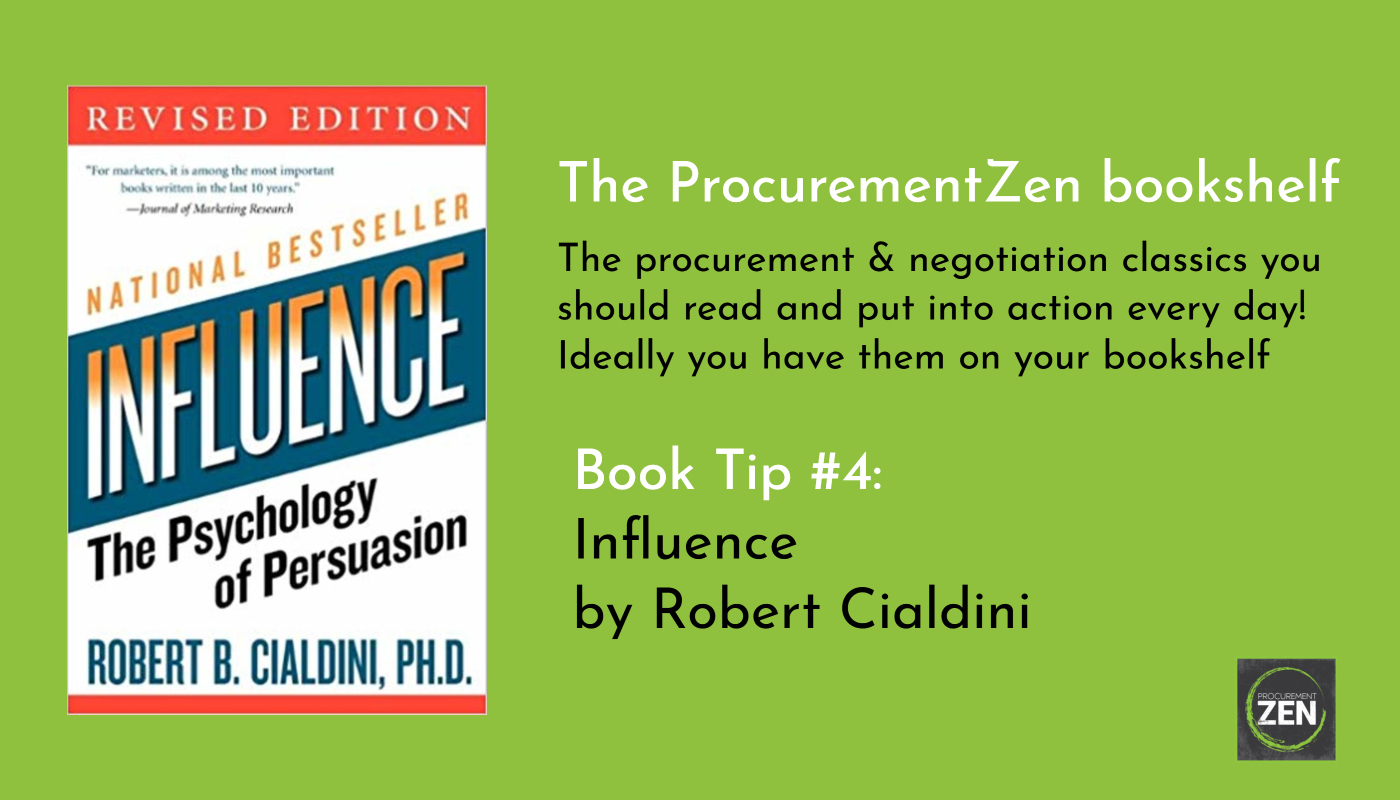
111 Negotiation Techniques - The Ultimate List (for 2020)
If you want to discover the all negotiation tactics in one place, then you’ll LOVE this in depth guide.
I selected and battle tested these 115 tactics myself.
And you can go through the list and choose by when to apply them and how aggressive they are.
Read on.
If you want to directly jump to a specific section, simply click the button below.









Negotiation Techniques: Anchoring, framing and reframing
Big initial numbers
Use big initial numbers, especially when you are presenting them on screen. 1.3 bn API calls sounds like a lot although it’s not, when it comes to Amazon’s web services. Research has shown that big numbers e.g. in a restaurant name result in guests paying higher prices.
Big numbers if you aim high, small numbers if you want low prices.
Look in the past technique
Refer to situations, where the other party has acted in the way we expect them to act now. Works because of Cialdini’s concept of consistency and commitment. For detailed explanation see this video on how to negotiate I published on YouTube
Reframing
This is putting a fact that is important to you to another frame of reference. A salesperson's motivation are incentives. But pro negotiator / buyer can reframe so the seller wants to solve the buyers problem e.g. better price. Even if that means, less revenue and less incentive.
Classical starters for reframing: “Let’s see it this way…” or “Consider seeing it from our point of view…”
But you can understand reframing can also as a wider approach. So I cover lots of reframing tactics in this category.. They follow all the same theme.
Reducing their expectations
This could also be an opening technique. You open negotiations by stating what is impossible to you.
Please don’t expect the order today. This is not possible with our processes.
Makes it very clear that we expect concessions from them.
Also very good in salary negotiations, by the way. Two variants:
Employer: We can’t pay you higher than your team lead, so please do not expect more than $85,000 p.a.
Employee: I’m sure you understand that every career step should also have a development in salary. Hence I cannot work for the same money as today.
Downplaying the other side
Downplaying here refers to downplaying the other parties facts.
Revenue recognition should not play that much of a role in our discussion
But it may be a huge issue for the salesperson, because it's his incentive.
Our rules
Our rules, also known as policy based negotiation, usually starts with these sentences.
We have never before … agreed to 10 days net payment terms.
We cannot accept… payment terms of 10 days net
and even more important...
It is not our policy… to accept any payment terms below net 90
Especially the first one - we have never before - is often used by salespeople. Combined with the look in the past technique (see above) it can be easy to overcome. Asking for proof is usually a good way to fight this tactic if applied to you.
Black and White
Black and white here refer to contrast. The color white is powerful when it’s in contrast to black. Much more as if we would contrast it to light green or pink. And the same is true for this negotiation approach.
This technique is about relation between topics. A famous example comes from Cialdini’s book Influence. Question: when would you sell the high class business shirt? Before or after you have sold the expensive suit?
Do yourself a favor and do it afterwards. Because in contrast to the money spent on the suit - e.g. $900 - $120 for a business shirt are a steal.
Structure your argumentation negotiations with business partners in a similar way. First the high license cost for the software and then the 20% maintenance fee. Not the other way around.
False Split
Following Chris Voss’ approach good negotiators never split the difference. This is also the title of his masterpiece, see my book review here. But in some cases you can do it.
You split the difference, when you have artificially increased the values. Hence your “share” of the split is more to your favor (but you don’t tell your counterpart).
This only works, if you don’t tell the other side before, that you never split the difference. Otherwise it might look suspicious.
Topic Jumping
Jumping around means changing topics that do not belong together. It’s a confusion tactic that you use to derail the other side. If you ask something, that is not related but through your use of words, you relate it.
This may not be a hard cut change. You could either use it by soft changes to before discussed items.
Thank you for mentioning your service level performance. While we are talking about performance. I want to get back to the maintenance pricing you offered.
Weak / inexperienced counterparts follow your route to your chosen topic.
Stroking one’s ego
Appealing to other’s ego is powerful but more framing than anchoring. It sets the frame in which the other side is willing to accept our requests.
You are important to us. We will consider you for our supplier award, if you could improve the conditions a little bit more.
Ever seen McDonald’s employee of the month sign? Ego stroking at its best.
Doing favors
Doing favors sounds counter intuitive. But it’s a strong weapon. Cialdini explains the reason this works so well in his book Influence. It’s one of the six key influencing measures: reciprocity.
Why is it in the anchoring and framing category? Because you set the frame of expectations here. Without saying it loud.
We humans tend to give back. It’s very hard for us to owe something. And if it’s only the smallest thing.
The magic of this negotiation tactic is that you give something of small value. Then place your important request early on in the negotiation. Humans want to pay their debt. It's likely that they fulfill your request.
I implemented this with a lunch plus some small gifts (like a branded notepad, some merchandise and a pen). It resulted in received discounts worth many times the value.
Flattery
Flattery and negotiation flattery (see next) are good initial framing exercises. They help to establish a positive mood (if this is what you want).
John, I saw that your company acquired Brownstone Inc. Congratulations, what a clever move. You have some very strategic thinkers in your company.
It is hard for us to not like these compliments.
Negotiation performance compliments
Negotiation compliments are a hardcore framing tactic. Use them to make the other party feel special. Once you have achieved this, they will do a lot of things to keep you in that perception.
Quite often I have seen that the other side became more gracious because I said something like this.
Great negotiation tactic, Jane. Have not seen it executed so well before.
After this compliment, they are more generous on other terms.
Use this negotiation tactic on small items. Then you can ask for a return on big items.
Gaslighting
Gaslighting is an aggressive tactic, so be careful, if you want to use it. Heard of Brexit? Perfect example for gaslighting. And no, I don’t want to make this article a political discussion.
Wikipedia describes “Gaslighting” as follows.
It's a form of manipulation in which a person or group sows seeds of doubt in a targeted individual. This leads to confusion, self doubt and not knowing, what’s right and wrong anymore.
Imagine a situation, where you promised a better price if they make other concessions.
James, I don’t know where you got this from. I never promised you better prices. All I said was that it's considered if the performance is good. But that is not yet the case.
Gaslighting is a mixture between lying, denial, causing confusion and (false) interpretation. It is somewhat of an ill-framing negotiation tactic.
If applied on you make sure that you stand grounded in YOUR reality. Ask for a break and try to re-frame yourself, if you fear, that the other side is gaslighting.
Open frames
You could also label using open frames as heating up the other side’s imagination. You use open statements, that seem like a response to the request. But they motivate the other side, to interpret them.
Imagine, you sent out a request for proposal. Your incumbent supplier has heard that he’s definitely on the shortlist.
Supplier: Come on, we know that we should get the deal.
You: You will hear from our lawyer
Supplier: Your lawyer? Why? Do you want to sue me?
You: As I said, you will hear from our lawyer.
Supplier (thinks): What have I done wrong? Did I cause a contract breach? Why do they want to sue me??
Even though legals only want to exchange contracts, this statement heated up imagination.
Introduction of new people
Introducing new people is an approach that allows to question before agreed items.
I’m John, I make the decision from now on, and we need to talk through a few items, that you consider closed.
Warning: You only can do this once with an existing party, because you will not be able to discuss it again.
If applied to you, you should have something in writing. A documentet that confirms the already agreed topics.
Electronic Negotiations
Electronic negotiations are bidding platforms like myHammer or eBay. This is also known as eProcurement. Procurement publishes tenders on these platforms on which suppliers then can bid.
Why is this negotiation tactic categorized as anchoring and framing? Because through the design of the tender, the negotiator sets the frame for everyone. No soft talk can change the tender, once discussions have started. This comes in as an opportunity to receive comparable bids from the counter party.
Comparability is important. It helps to overcome perceived differences in suppliers that are not existent.
Platforms range from enterprise solutions like Jaggaer to open source like OpenProcurement.org.
Power of the first action
The power of the first action - also known as first mover advantage - can come in very handy. This is especially true for anchoring and framing.
As we have discussed before, the first information often receives an importance bonus. This means that if you see a first offer as reasonable, you tend to go for it.
Let's review an example of a 1st offer that can make sense.
To make things clear from the beginning, we cannot go beyond $93 for the blue widgets.
If the $93 are within a realistic range this is the info all future discussions will relate to. By the way always use odd numbers so they look calculated (and not “guessed”).

Negotiation Techniques: Authority tactics
Authority by citation
This is a very common use of authority as a negotiation tactic. Reference to market reports or what I call “trusted third parties” do help a lot.
Looking at Payscale.com, James, shows me that your price of $87 / hour for a help desk technician is way too much. Salaries in this field usually tend to be around $17 / hr. Do you ask us for a 500% margin?
See my YouTube video on how to negotiate for an in depth explanation of authority.
Key here is that the authority you refer to is an accepted source of truth.
Authority in disguise
Hiding authority is exactly the opposite tactic than using it. You disguise that you have authority to make decisions.
You can use such a negotiation tactic to slow down the negotiation process. This is sometimes necessary if the other side pushes too hard. You may need to think things over. You may want to reflect topics with your team. Or you want to teach the other side a lesson (sometimes it's necessary).
“Authority in disguise” yet is better used in one off negotiations. It comes with the following risks:
- The other side asks “Who will make the decisions? Bring’em to the table” or
- They say “Don’t play games with us, we know you are the decision maker.”
In both situations, you will lose leverage and respect.
Better deal authority
The better deal authority is something every negotiator wants to have all the time. It’s the better offer on the table.
Johnson Inc. has offered us a 13.7% cheaper total price for this package.
This can work out but comes with certain pitfalls. The risk here is that your counter part responds with “well, then you should go with them”
Try to avoid these all or nothing situations. Rather connect the better deal authority with the liking approach.
We want to stick with you and hence need improvements in other areas. Can you improve payment terms to net 90?
If you apply liking - as you might have guessed - you should have enabled an atmosphere of trust beforehand. Good planning goes a long way.
Higher authority
As I have said elsewhere, this does not refer to religious topics. Higher authority relates to the authority in disguise negotiation tactic. And it bears the same risks.
It’s a reference to some decision makers not at the table.
Sorry, but I will never get this liability clause approved by management.
Generalization
Words like “always”, “we usually …” or “The market expects that…” are generalizations.
You apply generalization through using broad statements.
The 1st year of maintenance is usually included in the license price in the software market
Make sure that you do not drift into bigotry or even insults such as “in our country we do it this and that way…”. These rarely ever work from my experience.
Industry standard
Using an industry standard is very much related to generalizations. But it can be more specific, tailored to your negotiation situation.
I recently had a negotiation where colleagues rejected to provide a proper description.
They said
Don’t you know? We’re agile now. We don’t do service descriptions anymore.
This referred back to agile methodologies like SCRUM. They are very common practice in today’s software driven world. My counterpart - in this case a colleague - wanted to sell me on a simple idea. Let the vendor start to do the instead of first defining what we expected as an outcome.
Not too bad as an approach.
By the way, this was my response
You’re right, Jim. You don’t have to do service descriptions in SCRUM anymore. But you need to create user stories, so I am happy to take those, too. When can you deliver them? This week or the beginning of next week?
Use science
Using science relates to authority by citation. But the sources you quote in this negotiation tactic are all from the scientific world.
Using this approach is powerful. Today's world perceives scientific research as an “absolute truth”.
Imagine an internal discussion like this.
Peter, scientific research found out that the using the color “red” stimulates appetite. Can you thus consider redesigning our assets in this regard? [this is true, by the way]
The spouse effect
A classic in private negotiations. Waiting for the “significant other’s approval.” Ask any car dealer. I can guarantee, they can tell you endless stories about this negotiation tactic.
Using this leads to a slowdown in negotiations. You apply it, if you need more time. But make sure that before the negotiation you did not state that you are the decision maker.
Statistical data
Here’s another authoritative approach with reliance on 3rd parties. Like the science authority or authority by citation. But the twist here is using statistical data, for example surveys.
We did a survey among our users. We found out that the response rate to hotline tickets is way below the 90%. Don't forget that you promised them in a contract. That’s the reason for our claim.
Side effect: using this negotiation tactic? You control the survey. How many people did you ask and whom? If you want to achieve something specific, you may want to ask only a certain - very critical - group of people.
But don’t make this up. This would be lying. Ensure that you can provide proof, e.g. anonymized survey results.
Use “the community”
Using the community is a mixture between authority with a little bit of social pressure. Imagine, your company is also sponsoring the local football club. You could include this in your reasoning (and your presentation). Mention it when trying to convince the other party.
Oh, and last but not least on emore thing. 10% of the revenue we make with selling your product will go to Little Kickers Football Club. So you actively support the youth.”
It is a secondary tactic and should not be your main argument. At least only if you’re a fundraiser. But it can be the one small thing that motivates the other side to act as you like.

Negotiation Techniques: Deal Design
Demand Inflation
Have you ever purchased a car and wondered why the final price was so much higher then the offer price from the ad? You have been victim to demand inflation.
Usually, the other party (or you?) gets the food in the door with a very attractive offer and then - bit by bit - expands their piece of the cake.
Navigation system? Sure, take the Platinum 1100 at $930 extra. Need winter tires? We have an amazing set for this model for another $420.
This is also known as “the nibble” which have listed in my list of negotiation tactics here.
Upgrades
Related to demand inflation come upgrades. This is not an extension but rather the ask for a more expensive product. But for the same price as the original.
Madam, is it possible to get upgraded to a higher class for this flight?
In business environments this could be a better service for the price of the standard. The idea behind asking for an upgrade is that you do not get the upgrade you asked for but something still sticks.
Unrealistic counteroffers
Approaching your negotiation this way is quite aggressive. YOu make a high but fake offer. Fake here means “unrealistic”. Something that is impossible for the other side to take. Once the other side states, that this is not what they want (because it’s over the top), you step back. Then try to undermine the other parties reputation.
Mr Jones, if you can deliver 10 resources instead of only one, I would be willing to pay this increased rate..
Sorry, but you know, we’re not that big, so I do not have 10 resources to deliver.
Quite honestly, Mr. Jones, are you serious? I accept your high rate and you said ‘no’? Ok, then let’s revisit what we have here.
--- later in the same negotiation ---
You were not able to fulfill my earlier request, Mr Jones. Then let's rather talk about a price more into the direction I have mentioned .
Bundling
Usually bundling is a negotiation tactic applied by suppliers. But buying parties could use it as well. Bundle “worthless” options with your request and use this to improve your position.
We would also be willing to invite you to our supplier day, Mr. Jones, if you see a chance to accept our liability clauses.
Partial acceptance
If you hear responses starting with “yes, but…” you get partial acceptance.
It’s quite easy. You accept the part of the offer you like, but bundle it with another - unrelated - option from your list.
I want $35.47 per item and the testimonial you promised.
Ok, yes, agreed, but only with a 120 day payment term.
Counteroffer
Why do we mention counteroffers as separate negotiation tactic? Aren’t they the core of any negotiation?
Yes. And I use them in conjunction with my “giveaway list”. What does that mean? Let’s see an example:
I cannot pay the $35.47 per item you ask for, $32.13 is my absolute max. But I will introduce you to my colleagues for an opportunity to make more business.
In this negotiation tactic, the introduction is an element on my giveaway list.
By the way: You should always have such a giveaway list available.
Counteroffer rejection
It gets even more granular. There are some situations in which you reject any kind of counter offer. You do not respond to the offer on the table, which in itself could motivate the other side to improve their offer.
This is an aggressive negotiation tactic. It’s important that you stick to it and keep silent while rejecting.
Differentiate
Sometimes the other party tries to generalize you as a commodity. But you are not. Using differentiating tactics, you need to emphasize that you are “special”.
It seems like you are comparing us to your other customers. But we are not. We have locations in 52 countries. Our competitors on average locate in 8 countries. You see, dealing with us will offer you a much bigger reach.
By the way, this tactic is also used by vendors very often. Everyone is special and unique. If you encounter this tactic by a supplier, dive deep to uncover any “fake uniquenesses”.
Call for equality
Humans tend to be fair. Full stop. More often than not this is true. Hence the “call for equality” says “I feel I’m not treated fair.”
You have told us that you consider us an A client of yours. I assume that A clients receive some special treatment from your company. But all I can see are standard terms and standard conditions. I would at least ask for a similar treatment than other A clients.
Dramatizing
Using the dramatizing negotiation tactic can be very effective. You dramatize a certain point that in itself is not important. Later on in the negotiation you have something to drop. And you should rop it in exchange for a reasonable concession.
If others apply this upon you make sure to focus on the topics that are important to YOU. “Why should I care?” is the question to ask here. And “because I want them to like me is NOT the correct answer.”
Removing pains
This is yet another sales strategy turned into a negotiation tactic. Try to find out what the pain point of the other party is. Is it revenue recognition? Is it sales quota? Is it something completely different?
Try to solve that problem with your conditions and you will have a rock solid deal.
As this is a negotiation approach that is rarely seen by buyers, you can ensure that you get max attention. It’s a pattern interrupt and that’s always a good thing.
The Dead-End
As with so many other negotiation tactics, this approach slows down speed. For example when you need more time.
Sorry, Jim, but what you’re asking for is impossible. We never have paid more than $19.47 per item. Such a deal is not doable.
This negotiation tactic is also good for sparking the other side’s ideas and come up with new proposals. Some that are more in your favor.
Waste of Time
If you feel that you’re getting nowhere, use this negotiation tactic.
Sorry, but this does not lead anywhere anymore. We have reached a dead end and if I don’t hear anything new in the next 5 minutes, I have to go.
You can use this in 2 ways:
- As an indicator, if you can expect any movement from the other side or not. If within these 5 minutes nothing large happens, you are at a dead end. Then better pack your things and go. No deal is better than a bad deal
- And it can serve to place extra requests. Especially if all parties invested a lot of time already. Nobody wants to see this wasted. So putting a little bit of pressure in can help to close the final gap.
Accurate statements
Using accurate statements is more a mindset rather than a real negotiation tactic. Being precise helps.
Compare these 2 sentences:
We need to improve payment terms
versus
We need to to improve payment terms to 90 days net based on invoice receipt.”
Accuracy goes a long way here. Research shows that it's more acceptable to the other side when it's precise.
Giving responsibility
By giving responsibility you spark the “dream mode” of your counterpart.
Jim, tell me your title so I can put it in the contract papers.
You can spot this very often in private negotiations. The realtor who says “this would be the perfect home for you, I can see your kids already play on the lawn.”
It is especially effective, when the resistance is low in general. Or if other deal making tactics in this list have lowered it already.
Pro & Con Lists
Aaah, the good old listing approach. This is a very effective negotiation tactic. But it needs some preparation.
It works like this (3 easy steps):
- You collect some topics you want to request from the other side.
- Brainstorm pro’s and con’s for your request. Make sure that you have much more pro’s for your request
- In the negotiation, write them down. Do it on whiteboard, flip chart or similar. This is much more effective, if the other side can take part in its creation. So you don’t want to create the list upfront in your presentation software.
Of course, you could also turn this around. Listing more cons for an unfavorable request from the other side for example. Works the same way to make “their way” much less attractive.
Switch options
I think that others use the the switch options negotiation tactic more often on you as that you use it yourself. It works like this:
We don’t have this standard maintenance for enterprise level customers like you any more. But let me introduce our premium support to you.
It’s making options unavailable to the other side.
To fight back on this, you need to focus on your request. Label it (like Chris Voss suggests) like this:
It seems the options have switched.” [no denial, no accusation, no “I”]
If you want to use it, you could apply it like this:
We know you wanted to limit the liability to $100,000 per year. But this is no option for us, hence we have rewritten the clause to a $500,000 liability.
Late exchange
The Late Exchange negotiation tactic works like this:
So for the $10,000 we have agreed upon, we can give you $8,000 in cash. We pay the remaining $2,000 in 5 equal parts after services started.
As the name indicates, you use it late in the process. Usually a time when resistance is already low.
And it should come as a surprise to the other side. A classical pattern interrupt. In making this “extra” deal request, you could follow 2 strategies:
- Ask for something you want. In the example you REALLY want to split the payments
- Or ask for a "tradeable" item. Stick to it for as long as you can and then trade it for something else you want
Process Changes
Warning: Using this negotiation tactic will frustrate the other side! Because in the middle of the negotiation you change the negotiation process.
For example if you run an eBidding through an online tool. All bidders have placed their prices and all of a sudden you introduce a second round.
Yet, this is a good indicator, how much the other side wants to do business with you.
But you should only use this for commoditized materials. If you have a monopolist and they step away, because of frustration, you may be in trouble.

Negotiation Techniques: Listening
Speed of Speech
This tip is very short but works very good to uncover lies.
When people lie, their speech slows down and gets shrill.
Listen closely to any change in speed and sound of speech, note it down and ask (many) questions. This will help you in uncovering a bluff or a blatant lie.
Inactive Listening
This is yet another frustration technique.
Inactive listening means you are doing something different. You show no interest and ask many questions for repetition.
Jim, sorry, can you repeat that please?
It seems you are participating but somehow their message doesn’t come through.
Sorry, I was distracted. Again please?
It also works as a good pattern interrupt, if you change it with active listening (see below) in a fast frequency.
Listening by selection
This is also known as “selective listening”. It’s our standard way of receiving messages. We hear what we want to hear.
But if you add playback to this listening mode, you gain advantages.
We can get down to $13.27 per item, if you order 1,000 pieces or more.
Sarah, alright. So I noted down $13.27 per item.
It doesn’t work right away but is a nibble technique. If you do this over and over again, the other side sooner or later gives in.
Active Listening
Active listening is what you “should do”. That’s at least what everyone says. I would recommend that you select the listening techniques carefully. It depends on what you want to achieve.
Active Listening relates to labeling. See also Chris Voss book “Never split the difference” about this.
In active listening you complete what the other side has to say. You do this by feeding back what you heard. I would suggest, that you do not feedback with the words “I hear”. Instead use “it seems” or “it looks” (labeling, see my video on YouTube)
Competitive Listening
This negotiation technique can be mistaken for active listening. But it is a bit more aggressive approach. You listen as long as you have to, often interrupting the other party and giving back your view. It also includes how you (as in YOU YOU YOU) have perceived the message.
It is a very dominant and aggressive listening technique.
So for the price of $14.59 per item we can give you the premium coating. We understand that this is a little bit above your budget but …
I see. You want to charge us 23% more and we only get the coating on top. You are going a little bit over the top here. For me it feels like you try to squeeze everything out of our relationship and I don’t like that.
You see that the competitive listening response is all about “me”, “I” and “we”.
If you discover this behavior you know, you have a dominant personality type. You can find lots of info online on DISC personality types and on how to deal with these people.
You may want to use it if you want to gain (back) control over the negotiation.
Combative Listening
Combative listening is even more aggressive than competitive listening. But the main purpose here is to put the other side down. It is very close to insulting and uses phrases like
- “... don’t you hear what we said?”
- “... seems like you’re out of your mind.”
- “... maybe you’re not able to think this through.”
Again, strong indicator for D-types if you experience this from others.
Passive Listening
Passive listening is the exact opposite of active listening. At a glance it may seem relaxed but it is also an aggressive technique.
Because you do not notice what the other side is saying. Close to ignoring them.
Attentive Listening
This negotiation technique is also related to active listening. The one thing that’s different is that you do not respond or give feedback. You listen closely, focused. You could take notes.
The advantage of this approach is interesting:
You have much more opportunities to spot body language and non-verbal cues.
With a weak negotiation partner you increase their insecurity (if that is what you want). They cannot tell what you are thinking. Hence they are making up potential scenarios in their minds.

Negotiation Techniques: Negotiation Games
Silence
I love this negotiation technique. Make a statement, a request or wait for the other party to finish and stay silent. Don’t say anything.
It will feel awkward, if you’re new to this technique. But it works like a charm.
Very often the other side continues talking. They can’t stand the silence of a negotiation pro like you. And then they reveal new info, we can use.
Or they weaken previous statements.
Or make concessions without you even asking for them.
The most important part of "Silence" is to brief your teammates upfront. For them it will feel even more awkward because they didn’t speak themselves before the silence.
Make sure they do not destroy your approach.
This is also a major technique in Chris Voss' book which I have covered in depth in this video (and in this review of his book).
This silence even helps me (more often than not) to uncover bluffs.
High Shot
Applying this tactic relates to anchoring in general. The idea is that you open the negotiation with a high goal. If you wanted to achieve a salary of $105,000 per year, your would start with $125,000. Please remember, you usually don’t get more than your opener.
The art (and science) of this tactic lies in still being realistic.
Following the previous example, starting with $200,000 would still be a high shot. But it is simply ridiculous.
If your counterpart plays this negotiation tactic upon you, you respond with a low shot
Sorry, but we advertised this position with $75,000
Straight assumptions
The next tactic is quite aggressive.
Jim, I assumed you wanted to price this item at a price of $38.27 so here is an order with that price.
Poor Jim! It’s very tempting for him to take that order although the price may be way below what he expected.
You create the deal of your liking without any prior alignment.
Alliance assumptions
This is the softer version of the previous negotiation tactic. Following the previous example, your phrase your request like this:
Jim, knowing that you don’t like the administrative overload, I can do you a favor and have already prepped a PO for $38.27. I can execute on this if you agree and you can have the revenue booked in no time.
It’s not as blunt as saying “here’s the contract, sign on the dotted line” in the technique before.
Yet, playing assumptions on the other side is a quite aggressive tactic. No matter if straight or allied.
Brinkmanship
I have covered this technique already in my post on essential negotiation tactics.
The basic idea is to surprise with a huge request although the deal is close to done.
Jane, I talked to our senior management about approving our negotiated contract. They said, they only approve if you carry all the transition cost.
The concept that plays for you here is FOMO - fear of missing out. The other side gets the impression that they can loose the whole deal if they don’t accept your huge request now.
To be very honest: I rarely see that the whole request gets fulfilled by the other party. But usually it results in significant concessions.
Two things for you to consider:
- Don’t play this too often or the other side will reflect that as a risk buffer in future offers
- Don’t exchange that for a request you have made before. Ensure that the request is something you really want. It can be that you don’t get the whole number, but it should be the same type of concession. If you want price reduction, use brinkmanship with a high discount. If you want service extension, use brinkmanship with increased service levels.
Aggressive and to a certain extent an unfair tactic. But in an ultimate list like this I didn't want to ignore it.
Good Cop & Bad Cop
I’m sure you’ve heard of this one before. This is a very popular negotiation tactic.
One person in your team will play the bad cop, that is quite aggressive and even insulting.
Hear my words, I have never seen such a bad offer to our company. This is completely ridiculous. I will fight until my last moment to sign a contract like this.
And there’s the good cop. This should be the main negotiator in your team (although you may not want to disclose it).
He’s understanding, agreeable and open. He only asks for “something to work with”.
Sorry for John. Glad that he left the room, so we can now see, if we can find a way out of this mess. But I need something to convince him. Can we please discuss a better per item price? Oh, and by the way, do you want another cup of coffee?
New media aggression
This is also known as Public Electronic Aggression. Putting a big distribution list into an email with a complaint.
Or usage of a very aggressive online negotiation / eBidding tool, for example.
New media, because it uses tools like online platforms or email for execution.
Sorrow
If you don’t get this deal with us closed this week, you might regret it. We’re also in discussion with competitor Doe Industrial Inc.
This is a negotiation technique you can use, when you feel that your counterpart is insecure.
The trusted adviser
This is a very powerful negotiation technique. You let a third party speak in your favor. This third party is the trusted adviser.
Especially when it comes from the outside, it is often perceived as more neutral. As in “they must know, what they’re talking about”
The one thing, people tend to forget that the party that pays the bills determines what music gets played.
Jump around
This negotiation tactic describes opening issues that have been closed already.
To bear the very bad payment terms we must have a price of $3,427 for phase 1
But we closed the pricing already…???
Whatever, we need to talk about pricing because these payment terms kill us…
Be sure to not make any written statements about what topics you have closed and which not. Otherwise you would lose credibility.
Early price closing
This technique is you as a buyer asking for a price very soon.
Ok, Martha, let’s discuss the elephant in the room first: What’s the item price?
You force the other side into shouting out their price before they are ready to do it.
There are other factors that influence the price further down the road. If you know that and you assume it will have a negative impact on your price, then close the price early.
It’s the opposite tactic to jumping around. You refuse any re-opening of pricing. So make sure, you don’t use both negotiation tricks in the same discussion.
Re-Focus
It happens to the best of us. You go into a negotiation with a certain assumption. When you leave negotiation 2 hours later, you wonder, how different it turned out.
So did you read our revised version of the contract, we sent you last week? Can we talk about liabilities and cooperation duties?
Sorry, no, because I have to inform you, that we have to sue your company, because of a breach of license terms.
This negotiation game will completely re-focus your attention.
But, as in the example above, you could use it also in your favor
Sorry, Jane, but instead of talking about prolongation, we want to talk about phasing you guys out.
This will completely derail their strategy. They might make some important concessions in this very meeting.
You against yourself
This negotiation game is very effective. You let the other party make their offer and show no reaction to it. You hold to this "no reaction" as long as you can.
The other side, especially when they are insecure, will feel like they did something wrong. And then they themselves improve their offer.
This second offer then fights against the first one.
You can do this in a few iterations (not too many) until you have the feeling, you won’t get a better offer. Then you start negotiating in an active way aka giving a response to the offer.
Locking in
In this negotiation game you introduce the negotiation with a few important preconditions. These limit the other side’s options, before you even start.
Sam, thank you for coming. Before we start, here are some rules of the game. First price must not be higher than $14.57 per item. Payment terms are net 90 and the delivery time must not be longer than 8 working days.
Even better, if you can reason these preconditions. Providing rationale makes these preconditions more “believable”.
Caution: This might motivate the other side to not even start the negotiations. As in “... if these are your conditions, we can end the meeting now.”
Changing importance
Making unimportant things important before making concessions on them. Of course, concessions only to get something in return.
Also known as the fools gold game.Nothing is as shiny as it seems.
Once you have received what you want, the important issue is no longer important at all.
Weak point attacks
If you spot a weak point in the other side’s negotiation team, you attack it.
For example a new executive or sales lead who wants to prove themselves.
Or an expert on the other side who confirms some of your points.
You recognize that the other side is not aligned as well as they thought they are. Leverage these weaknesses to your advantage.
E.g. address the fame the new executive could gain when closing a deal with you in his first month.
Or refer to the technician on the other side who said you were right. Praise his technical knowledge. And use it against them.
Stonewalling
Let the other party run into a stoney wall of communication. Give vague responses. Don’t be concrete. Make communication with you very very difficult.
Okay, Jim. Thanks. We must revisit this point later.
If they ask you for something, don’t respond. Instead give a “we’ll see” answer.
Important: This is definitely a negotiation game which you have to inform your team about. If you’re vague but your teammates are concrete, it makes you look stupid.
Artificial complication
Always make things more complicated than they need to be.
- Provide very complicated clauses for easy topics
- Connect issues that are not related to each other
- Complex to very complex calculation procedures
And - key to this negotiation technique - weave into these very complex topics your core requests.
As we have shown you in the last 12 slides, this is how we have calculated the hourly rate.
This is a tactic to derail the other side and make the negotiation lead look weak. If you want to get rid of him or her, this is one of the core negotiation games to use.
You say “Could be a good idea that you provide someone who understands this better.” This will help you to strengthen your position.
Vanished budgets
This is a commercial negotiation game.
Thank you, Sandy, to come to our final meeting. Unfortunately we cannot close the deal as discussed. We received a budget cut after our quarterly financial figures. Because of this we need to reduce the pricing by another 23.1% to $15.91 per item
A well-known principle of human behavior says that when we ask someone to do us a favor we will be more successful if we provide a reason. Hence use the word BECAUSE!
Robert Cialdini in "Influence"
You want to close the deal both parties have been discussiing so long, but you cannot afford it due to "lost budget".
If you are a publicly traded company you can use a stock price decrease to your advantage here.
New brooms
A new broom sweeps clean.
Have you heard this proverb before? You can use it in your next negotiation. You exchange the lead negotiator.
He or she has to play hard ball on some closed topics to achieve extra concessions.
Hey, Tim, I’m Phil. I took over the lead of this project from Steve. The pricing topic the both of you have discussed is not valid to me. We need to improve the item price to come to a deal.
This works very well, when you know, you have different tasks to work on. And you don’t engage with this vendor anymore. Because for this specific party you lose ALL credibility. Not a problem though, if you don’t need to communicate with them anymore.
Pick the lesser evil
To apply this negotiation game, make two very bad offers. Then try to force the other party into picking the lesser evil.
As simple as that.
Stick to these two offers as long as possible. Say things like
We have made another offer as well. If these terms on the table don’t fit your needs, let’s discuss the other offer.
Deal makes me angry
This deal makes no sense to me anymore. It seems we can break off discussions. I don’t hear anything new. Let’s stop discussing it.
This is a very popular hardcore tactic in dealing with automotive manufacturers. But of course it is not limited to this vertical only.
It is comparable to the good cop / bad cop game described in this series. The only difference is that you don’t need a good cop.
Let them make better offers to get you back to the negotiation table.
Offer withdrawal
You apply this negotiation game late in the deal.
Sorry, but under these circumstances, a deal is no longer possible. We have to withdraw our concessions.
It plays - once again - with FOMO, the fear of missing out.
The other side feels the effort they put into the deal was in vain. They make more concessions to keep what they have.

Negotiation Techniques: Physical approaches
Tactile warmth
Providing a warm beverage, especially in winter time. Warm and cozy rooms.
All these approaches work with tactile warmth. There is scientific research that indicates that tactile warmth leads to more concessions. See this article for example.
Sweets
Like "tactile warmth", providing sweets will also lead to more concessions. There is scientific proof for this.
Higher glucose levels help our counterpart to see our requests in a favorable light. Serve sweet food instead of sausages etc.
Atmosphere of trust
Before entering the meeting room give the other side a tour of your factory. Or your offices. Make sure to mention the following.
You know, Samantha, this is usually not possible. But as you are a trusted partner, we are happy to give you more insights than our standard vendors.
This leverages them to a special position. And it makes them want to “honoring your trust” by making concessions.
Noisy environments
Choose a meeting room in a noisy space. Then mention important topics in a slow and quiet voice. This raised the other side’s attention and puts a lot of “extra” focus on your requests.
Open a window to the street for example or leave a door open.
The famous psychiatrist Milton Erickson used it in his sessions to great success. Learn more about one of the founders of NLP here.
Reducing physical distance
This is an advanced negotiation technique you could use to your advantage. Draw something on a flip chart and then bring it physically closer to your counterpart.

This will raise the attention and bring your “topic” into their main focus.
You also could use hand-outs instead of a flip chart and print them out (oversize if possible). Then move these items closer to the negotiation lead of the other party.
Person focus
Always be sure to be in the focus of the other party’s leader. If you’re the negotiation lead, don’t sit aside. Make sure, they can see you.
This is another attention grabbing technique I extracted from “Pre-Suasion”.
What gets attention will make the topic more important. Hence it's more likely to get an approval from the other side.
The gender game
Sad but true: if you’re dealing with a dominant negotiation lead they try to impress the opposite sex.
Use it to your advantage. If you’re dealing with dominant males ensure that a woman places the important requests. And vice versa of course.
Negative body language
Use negative body language if you are not satisfied. This includes
- Crossing your arms
- Putting your head down
- Crossing your legs
- Disappointed facial expressions
- Shaking your head
This works very well if you are older than the person on the other side you’re dealing with. Your age gives you an experience bonus.
This leads to self-improving offers and more concessions.
Shake hands
This negotiation tactic is very powerful especially in western culture. Yes, we talk about contracts and papers and documents all the time. But a firm handshake on an important topic usually seals the deal.
Thank you, Amanda. That was a long discussion. Let’s shake hands on this agreement.
Although - of course - a handshake is not legally binding, it comes close in strength to a signature.
It’s a sign to stand in for a promise the other side has made.
The hunger games
No, this has nothing to do with the book / movie. It’s rather using hunger to your advantage.
Before we go to lunch, James, we need to get the payment terms off the table. So can we agree on 90 days net?
You refuse to provide food before the other side makes a concession.
Even more powerful, if you have food delivered but do not allow “to touch it” before the other party agrees.
Nice weather
A 2003 study found that we are more willing to take risks and are more agreeable in nice weather conditions. Good weather seems to lead to a better mood which in return leads to more concessions.
There is also a nice article by the Edge Negotiation Group on this effect.
Time of day
If you can choose a morning session to improve your negotiation results. Studies haves shown that the morning increases the chance of agreement.
I have used this quite a lot in combination with the hunger games negotiation technique.
Start at 9:00 am and make sure to have an agenda point that refers to “re-focus” or “open topics”. Then use these last 30 minutes to combine both approaches.

Negotiation Techniques: Questions
Ask OR questions
If you want to know where you stand in your negotiation, you should ask OR questions.
Bob, are you satisfied or unsatisfied with the clauses we discussed on liability?
These do NOT prime your counterpart on only one view to the question (are you happy…). Instead you open it up and ask for their honest opinion.
Helps to uncover black swans aka deal breaking problems, you were not aware of.
Self Perception questions
Sam, would you consider yourself a helpful person?
Bob, do you see yourself as innovative?
Jane, are you someone who can make a decision?
These types of questions relate to the other side’s self perception. The reason this works so well is because of consistency. We want to be consistent with what we said before. Especially if previous statements related to our personality.
Open ended questions
Use this if you want to dive deeper into a certain topic. Or if you need to gain more information from the other side.
Bob, what’s the reason for your suggested payment terms?
An answer to an open ended questions is never yes or no. Also, I would suggest to phrase them neutral. This motivates the other party to speak more.
Compare the previous neutral open ended question to this one:
Bob, why are your payment terms so short?
The first one may help you uncover if they have a cash problem, which could be something you can help them with. The second version only creates tension. The other side is likely to enter into a fight rather than providing reason for their point of view.
Precise questions
Instead of asking “can you make a better price?” ask “Can you improve the price to $38.57 per item?”
And odd number is very important here, because it seems like it’s calculated (and not guessed).
Repeated questions
Repeat your question again and again. THis motivates people to dive deeper and deeper into their reasoning. While doing that, the other side often times discloses very valuable information.
This works well if you use the question “why”.
This liability clause is hard to accept for us as a seller.
Why?
Because it puts an unnecessary high risk on our side of the deal.
Why is that?
Well, you know, our insurance is only up to the level you ask for. This makes it hard to accept.
Why?
Because if we reach the threshold with this 1 deal, there’s no other deal we can make. At least not under these insurance conditions. We would need more limits which cost extra money.
Why?
… and so on…
Close the gap
Sam, do you think this is all for the pricing and conditions annex? You can do better than that.
This indicates that you see a gap they need to fill. Best option now is to fill it yourself.
If we would accept an increased min order quantity of 500, can you lower the price to $93.65?
You open and close the gap with your request.
The Love Sandwich
Sandwich your request with positive beginning and end.
Sam, others will recognize you as an amazing account manager in your org. Accept our 90 days payment terms and close this deal today to reap the rewards.
To have some love munition, try to come up with a list of at least 10 items that you can use in this negotiation technique.
Close ended questions
This is the exact opposite to the open ended questions we discussed in this series. A question that one can only answer with yes or no.
John, please tell me: Do you accept these payment terms, yes or no?
Marty, do you want to close a deal with us?
In the first example, we even added the “yes or no” part to the end.
Moving questions
Tim, we’re not really discussing payment terms here, right? For me it looks like we are discussing cash flow and liquidity. Can we please focus on the core?
Sandy, this deal is not about the testimonial you ask for. It is rather about getting a good price for the items we want to buy.
This negotiation technique helps you get back to your core. The topics that are important for you. A good sales person is able to distract you from your core requests. Using the moving questions tactic helps you get back there.
Curious questions
Using curiosity is a great opener for any negotiations. Besides the opportunity to gain valuable insights, you show interest in others.
Make sure yet, that your curiosity question relates to the deal at hand. Don’t ask what they did on the weekend, this is small talk rather than a questioning technique.
Justification questions
Sam, how do you justify an hourly rate of more than $25 for this level of expertise?
This is using justification questions as a negotiation technique.
It is quite an aggressive move, because it forces the other side to come up with reasons why these prices are “valid”. Important to stay silent after posing your question.
If they do not answer or say something like “we don’t have to justify” this is a clear indicator, they can’t justify it. It can be that they did a blind shot price estimate.
Either way, both responses - nothing or justification - give you good angles for attack.
Probing questions
You could also describe this negotiation tactic as “poking around”. You are asking all kinds of emotional questions. Questions to trigger a response from your counterpart.
Don, are you serious about the pricing terms?
Bill, is that the best description you can give?
Amanda, don’t you think you can do better on payment terms?
Serious / Best / Better are the keywords here.
It’s somewhat of an introductory tactic if you don’t have an angle to work with. You probe and see what comes up (and what you can use).

Negotiation Techniques: Storytelling (& Acting)
Subtle slides
This is another negotiation technique to grab (and keep) the other side's attention.
Let’s imagine you want to improve your payment terms in a contract negotiation. Payment terms are a cash flow topic.
Create a little slideshow or one page slide that runs in the background (as some kind of screensaver).

It should show how important cash flow is to you. For example your CFO saying that this year's focus is on cash flow.
Paint a little one page slide how it could look like
Or a press article that indicates that your cash flow position currently is very good (e.g. from an analysts call).
You do not refer to that slide again. All you do is you subtle prime them for the upcoming topic (and how important it is to you).
By the way... Do you need a surefire way, to improve your slides NOW? Want to make sure YOUR message gets heard? Then download my free ebook.
Dumb and Dumber
Have you seen the movie with Jim Carey? You wouldn’t believe it but it gave me some inspiration for this negotiation tactic.
You ask stupid questions or act a little dumb.
Dan, you said that the monthly cost for your SaaS offering is less than a daily meal. So we adjusted the pricing.
Imagine Dan looking at our changes to discover it’s $30 / month instead of the expected $300 / month.
Wait, this says $30. That’s way too cheap.
But I bring my own food and never pay more than a dollar per meal.
Side note: You have to be good actor this way. From a psychological perspective you're setting your anchor.
There’s no way back
The famous point of no return. This negotiation technique values the effort that already went into making a deal.
Bill, we invested so much time into these discussions. Do you think that delivery time should be a deal breaker here? We don’t want to throw it all away.
Emphasize how much effort everyone put into “this thing”. That it’s not worth throwing it all in the garbage can for that one small request you have left open.
Use this negotiation tactic late in the process and only for major issues that are still open.
Insulting
Dan, a professional key account manager could do much better than this.
Donna, how long do you own this customer account? A good sales rep should know us better.
This aggressive negotiation approach is a personal attack on the other side. This works wonders on weak counterparts. Usually they know that they’re weak and you show that you know it too.
Use only in conjunction with other strong / aggressive negotiation techniques.
Fuming
Imagine this:
Bob, I have enough, this annoys me and it’s time for you to leave.
Then you storm out of the room.
These days we’re told that emotions should stay out of business. But I would recommend the opposite. Use them and use them in an appropriate way.
When fuming (and shouting gesticulating, leaving the room in anger) you take over the lead. This can be in combination with the good cop / bad cop approach or used as a single tactic. As we are so trained on being “un-emotional” fuming is not something one expects from you.
This is not only a pattern interrupt. It usually leads to larger concessions because the other side feels very uncomfortable. They want to bring you to normal level again. Quite often, improved concessions are their measure of choice.
Excuses
Excusing is the exact opposite of the fuming tactic we discussed above.
Bob, I am sorry, that you have so many difficulties with reasoning a good price for us in your own organization. I want to apologize for that and also want to support you in finding a way out. A way that would work for both of us.
This negotiation tactic works often times wonders with dominant personality types. Because they want to be in the lead. If they receive a soft and passive answer like this, they feel confirmed in their personality. And they are willing to give more than intended, because they “won” over you. And winning is everything for a dominant type.
Confusing others
This negotiation tactic is very helpful if you want to hide certain things.
Bob, you have said that you do not accept our payment terms. This leads to a worse cash position for us. A worse cash position will have an impact on our product pricing and how we can place and market this globally. Looking at marketing, online advertisement prices are increasing. Due to this we cannot afford to promote our joint partnership anymore.
What you’re doing here is to build an irrational line of arguments that are not related to each other. But you connect them. In an artificial way so to say.
Complaining
Debbie, I do not like that we have limits in liability in our contract. Besides that, the contract is a good deal.
A late in the process negotiation tactic that helps you to leverage all that you have achieved. Use that leverage to kick the last few open items.
To use this negotiation tactic in a professional way, try to come up with a “bucket of complaints”. Then can use them when applying this trick in a negotiation.
Consistency (and commitment)
This is one of the core influencing techniques. It's introduced in the greatest negotiation book of all times. “Influence” by Robert Cialdini.
You apply it by reminding your counterpart of the “need” to be consistent.
Donna, the last two contract extensions, we kept the maintenance fee to 15% of the license price. Now you come up with 23% and this is not consistent with previous prolongations. To keep the good relationship, please keep this at the 15% level.
But it’s not like collecting yes’s as I have laid out in this video on the ProcurementZen Youtube channel.
If you want to know more on the other books on my top list, head over to my post on the best negotiation books. You'll also get a cheat sheet for Cialdini’s book, too.
Misreading others
You could also label this negotiation technique as intentional misunderstanding.
Phil, it is time to discuss a price increase due to increase cost of labor.
Sorry, Don, are you serious? You want to throw out our 4 yr relationship for a tiny increase of price? You don’t mean that, do you?
Your response to the price increase from the other side is the misreading technique. This is a very good example I have seen a lot because it covers to important points:
- Over dramatizing the initial request from the other side…
- Anchoring a “tiny price increase”
It’s a very powerful negotiation tactic to start discussions with your counterpart. It sets the right frame.
Keep your good name
David, you are the key account manager and cannot risk your prominent position. Don't make the decision of losing us as a customer for such a small topic like payment terms.
This relates to the “stroke the ego” technique discussed in this series. But it requires more acting from you as a negotiator.
In most of the cases you do not care what role or function the decision maker on the other side has. But in this negotiation tactic you focus on it. And use it to your advantage.
Social Proof
This is another negotiation approach that comes from Cialdini’s masterpiece “Influence”
Sam, our service center takes 1,300 calls a day. Can you miss out to be part of this opportunity with your software?
Damien, have you seen who else has partnered with us on this platform? It’s the Big5 in the service niche. Can you risk to stand out from this elite group?
Using social proof can come in a lot of ways. But in this specific part of the series it also includes a little bit of exaggeration.
Maybe 1,300 calls is not that much, maybe the Big5 are not that important but you’re acting as if they were.
Want more of these "ready to apply" tactics from Influence? I have created a FREE cheat sheet where I put these principles into action.
Awards bait
Sam, you did a great job in our relationship. You definitely deserve the rewards for closing this contract, too. Don’t let it slip away because of a minor topic like cooperation duties.
You are providing some kind of entitlement. The magic of this negotiation technique for the other side is the question “do I need it?”
Negotiation Techniques: Conclusion
So this concludes my Ultimate List of Negotiation Techniques.
Did I miss anything? Let me know.
Was your favorite technique not included in here? Leave a comment below and I'll add it ASAP.

